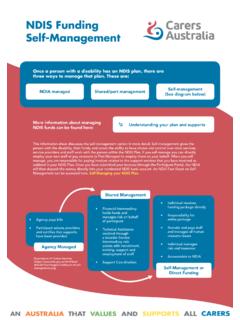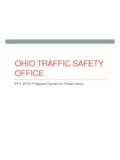Transcription of Pennsylvania’s New Transportation Funding Law …
1 Pennsylvania s New Transportation Funding Law Detailed Summary of Act 89 of 2013 Summary of Funding Levels Under Act 89 Transportation Mode Year 1 (Jan. 1-June 30, 2014) est. Year 5 Estimate State Roads and Bridges $188 mill ion $ billion Public Transportation $60 million $497 mill ion Local Roads and Bridges $35 million $237 million PA Turnpike Expansion Projects $13 million $86 million Multi-Modal Fund $30 million $144 mill ion Fish and Boat Commission $3 million $9 million County/Forestry Bridges $2 million $12 million Dirt/Gravel/Low-Volume Roads $35 million TOTAL $331 million $ billion Overview of Funding Levels.
2 Generates additional $ billion per year by FY2017-18 for the Commonwealth s highway, bridge, public transit, local government, and other modal infrastructure systems. Generates an additional $ billion per year for highways and bridges by 2017-18. Generates an additional $476 to $497 million per year for public transit by 2017-18. Provides an additional $220 million per year in fuel tax revenue for local government highway and bridge projects by 2017-18. Establishes a new $144 million per year Multimodal Transportation Fund by 2017-18 to fund Commonwealth aviation, freight and passenger rail, ports and waterways, bicycle and pedestrian projects.
3 Allows for PennDOT to achieve $1 billion in savings over 10 years as a result of improved efficiencies. Changes to State Fuel Tax Calculations: Effective January 1, 2014, the new law eliminates the 12 cents-per-gallon state retail gas and diesel tax. Also effective January 1, 2014, a corresponding increase in the millage rate of the Oil Company Franchise Tax (OCFT) is increased to offset and make the 12 cent elimination revenue neutral to the Commonwealth. The OCFT is a tax on gasoline and diesel at the wholesale level or at the rack. Under the current formula used to calculate the tax, an artificial cap of $ was applied in 1983 effectively suppressing revenues and the ability for the current wholesale price to be used Page | 2 when calculating the tax rates.
4 In today s market, the wholesale price of gasoline is approximately $ The law uncaps the OCFT over a five-year period. The OCFT is adjusted as follows: o Increases the cap to $ on January 1, 2014. o Increases the cap to $ on January 1, 2015. o Eliminates the entire cap on January 1, 2017. o A new floor price is established at $ on January 1, 2017 to protect the state from any sharp declines in price. The five-year phase out of the OCFT is estimated to generate an additional $ billion annually. OCFT revenues are constitutionally protected for Commonwealth highway and bridge programs. Changes to Vehicle Registration Fees: Basic passenger car registration fees will increase from $36 to $37 in 2015-16 and from $37 to $38 in 2017-18.
5 An inflationary CPI adjustment would then apply increase every two years starting July 1, 2019. Pickup truck registration fees will increase from $ to $60 in 2015-16 and from $60 to $62 in 2017-18. Inflationary increase every two years thereafter. An inflationary CPI adjustment would then apply increase every two years starting July 1, 2019. Trucks (Class 2-4B) registration fees will have an inflationary increase starting July 1, 2019 and every two years thereafter. Commercial and non-commercial trucks 11,001-80,000 lbs. (each weight-class Class 5 through Class 25) will see a phased-in increase beginning 2015, for example: from $243-$263 for class 5 & $1,687 to $1,827 for class 25 in FY 2014-15 from $263-$283 for class 5 & $1,827 to $1,966 for class 25 in FY2015-16 from $283-$303 for class 5 & $1,966 to $2,105 for class 25in FY 2016-17 from $303-$323 for class 5 & $2,105 to $2,244 for class 25in FY 2017-18 o Inflationary increases every two years thereafter.
6 Buses, school buses, limousines and motor homes will have a similar phased-in increase beginning 2014-15. Inflationary increase every two years thereafter. Motorcycle registration fees will increase from $18 to $19 in 2015-16 and from $19 to $20 in 2017-18. An inflationary CPI adjustment would then apply increase every two years starting July 1, 2019. Antique/classic/collectible car registration fees will increase from $75 to $77 in 2015-16 and from $77 to $80 in 2017-18. An inflationary CPI adjustment would then apply increase every two years starting July 1, 2019. Other registration fee provisions: o Optional biennial registration for all vehicles other than those subject to the International Registration Plan.
7 Takes effect in 2017. o Local Government option for counties to assess a $5 vehicle registration fee to meet local government needs. Changes to Driver Licensing Fees: Remain at a four-year renewal period. Increases the base licensing fee from $21 to $22 in 2015-16 and from $22 to $23 in 2017-18. An Inflationary increase is applied every two years thereafter. (An additional photo processing fee still applies as per PennDOT regulations). Page | 3 Changes to Traffic Violation Fines, Surcharges and Permits: Increases several existing surcharges on certain serious moving traffic violations by 50% which is estimated to generate an additional $86 million annually by the fifth year of the new law.
8 These funds would be dedicated to public transit Funding . A flat $150 fine is established for violations of section 3111 of the Vehicle Code (Failure to Obey Traffic Control Devices), which is estimated to generate an additional $40 million annually. A portion of this fine is dedicated for public transit. Establishes a new option to pay an increased $500 fine in lieu of a 90-day suspension for lapses in insurance. This is estimated to generate $7 million and would be dedicated to public transit needs. Redirects to public transit revenue from eight fees currently deposited into Motor License Fund, but not constitutionally restricted to the Fund.
9 This provision is estimated to generate an estimated $265 million per year by fifth year. Inflationary adjustments are made to various PennDOT fees, including license plates, overweight/oversized hauling permits, occupational limited licenses, CDLs, and probationary licenses. Local Government Funding Provisions: Increases the 52-year-old Prevailing Wage Law threshold that determines whether state prevailing wage rates shall be paid for local Transportation projects (those funded by local governments). The threshold of $25,000 is increased to $100,000 effective 2014. Local governments will receive an additional $220 million annually by the fifth year in direct allocations from the OCFT increase.
10 This represents a 60% increase over current allocations to local governments. Allocates up to $40 million in grant money by 2016-17 to coordinate traffic signals to alleviate congestion. Allocates an additional $30 million for the Dirt & Gravel Roads program bringing it to an annual $35 million program. o A minimum of $8 million annually for the paving of low-volume rural roads. o $28 million is dedicated for State Conservation Commission grants and $7 million to DCNR. Allows local governments to save up to 20% of local matching funds for each bridge under PennDOT s new bridge bundling program that was established in the new law.





